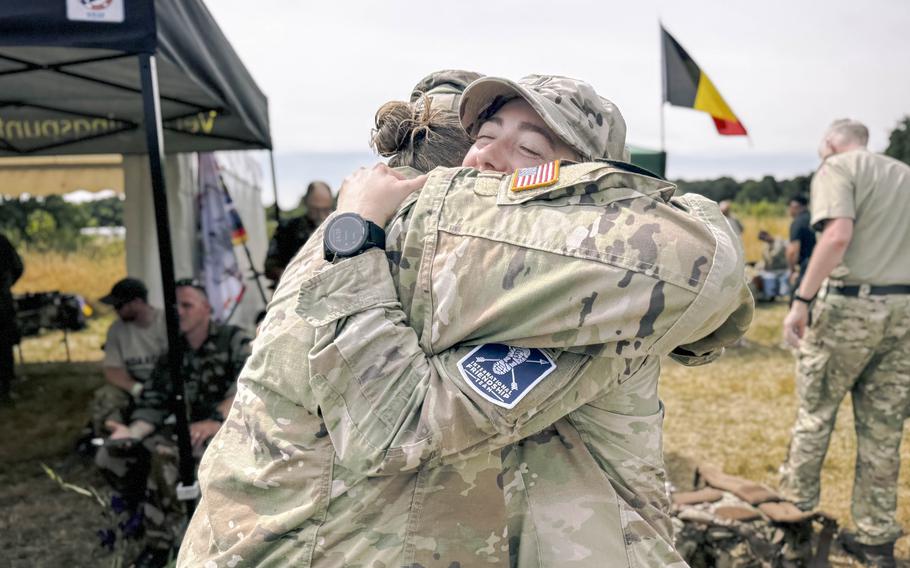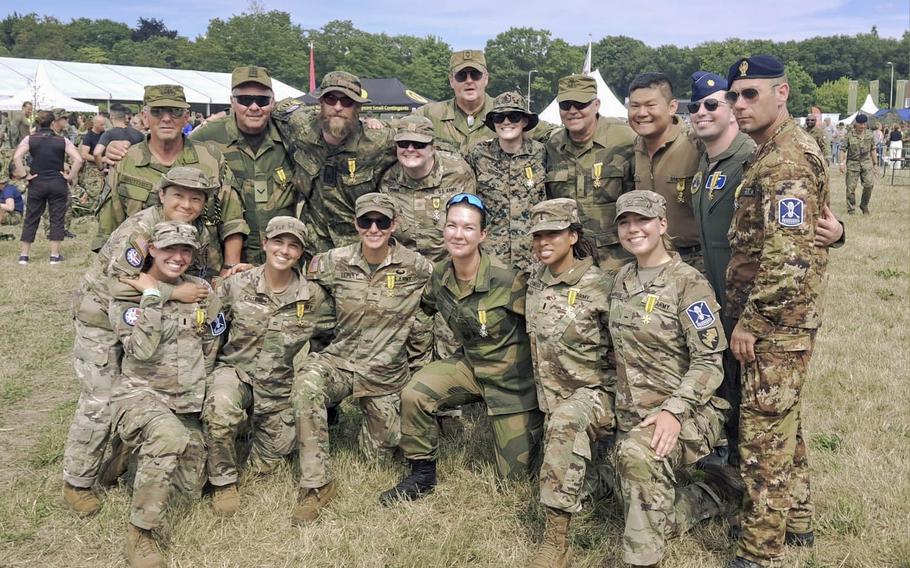
Army Maj. Samantha Turner hugs 1st Lt. Mercedez Fernandez after pinning on her medal for completing the 100-mile-long Nijmegen Four Days Marches in Nijmegen, Netherlands, on July 18, 2025. (Lydia Gordon/Stars and Stripes)
NIJMEGEN, Netherlands — “You’ll Never Walk Alone” is a song, a soccer anthem and a sentiment, glimpsed in passing recently on a roadside sign by service members marching 100 miles through the eastern part of this country.
The words captured the spirit of last week’s Nijmegen march, which serves as a test of endurance, leadership and collective will.
Each morning, hours before sunrise, our international team of 17 service members laced up boots in a cramped bunk room at Camp Heumensoord, a few miles from the border with Germany.
Day One of “De 4 Daagse,” or Four Days Marches, begins festively and grows more challenging as the first 25 miles tick by.
The event began in the Netherlands in 1909 with military roots, originally designed to simulate the long treks soldiers had to endure. Thousands of service members from around the world now join in, along with an estimated 40,000 civilians marching and tens of thousands more cheering on the participants.
Day Two is the toughest, Maj. Samantha Turner, an Army reservist and our team leader, warned us when we arrived. “After that, you just accept your fate,” she said.
Fate dealt a lot of soreness, throbbing feet and tight muscles. Turner knew what she was talking about.
This was her attempt at completing her ninth Nijmegen March, which she called “the most fantastic leadership (event) that you can participate in.”
A year earlier, illness had forced her to stop marching after the first day. She returned determined to finish what she started.
“I keep coming back because it’s such an excellent way to test your mettle, your grit, your leadership,” she said. “But also, how … you inspire people to push through.”
We stepped off into the dark on Day Two, cadences echoing from our multinational formation. Service members in our team from the U.S., Norway, Germany, Italy and Singapore marched past the oversized helmet and boots marking the camp’s gate.
“Here we go again! Same old s--- again,” echoed the now familiar call-and-response melody.
“Forty K and we’ll be through,” Turner called back, adjusting the lyrics with a smirk.
Since 1925, the city of Nijmegen has hosted the event’s official start and finish.
Each day starts with miles of staggered global military formations trudging down a dirt trail and through sleeping neighborhoods before merging with the crowd of civilian walkers.
Supporters lined the route with signs, snacks and music. Children called out for patches, stickers and high-fives.
Our flag bearer, German army Master Sgt. Johannes Mannsee, jogged out of the formation and handed children stickers and patches.
Even as rain poured down on that second day, the three West Point cadets joining our formation stayed upbeat. Sienna Tepley, Maria Miroshnichenko and Ava Critcher pressed on with the same resolve as the veteran marchers beside them.
“The next military rest point is only three klicks ahead,” Turner announced to the formation around Mile 16.
We had a time to beat, after all. Every military team was required to return to camp before 5 p.m., regardless of the start time.
But every painful step beyond that estimated distance felt like a mile. The only thing keeping me going was the thought of resting my feet, even if only for 10 or 20 minutes.
Yet when I looked around at the marchers beside me — military and civilian, many with their heads bowed, slowing and falling behind their groups — it reminded me we weren’t alone in the struggle.
“I see that all the time … where people get left behind (during) rucks (and) runs that we do,” said 1st Lt. Mercedez Fernandez, of the 173rd Airborne Brigade. “Here they were supported and (our group) all finished together with 100%.”
For Fernandez, it was a reminder of what leadership is supposed to look like.
“I definitely think that my leadership style has … been reinforced and inspired,” she added.
Day 3, officially known as “the day of seven hills,” loomed over us.
To keep spirits high, our team found small distractions, such as light-hearted bets on how many times we’d hear “Baila de Gasolina,” a catchy hit by the Dutch band Effe Serieus that played on speakers along the route.
The whole team cheered each time we added to the tally. We couldn’t quite decide if we genuinely liked the song or if it was becoming part of our collective insanity.
Every mile and hill came with challenges, but our formation never went silent. Someone was always calling cadence, cracking a joke or offering a word of encouragement to keep us moving.
Our team began mostly as a group of strangers. But by the final miles, we had lived together, walked together and endured pain side by side.

Members of the International Friendship Team pose for a photo at the Field of Charlemagne in Nijmegen, Netherlands, on July 18, 2025, after all 17 members completed the 100-mile Nijmegen Four Days Marches, the largest multiday organized walk in the world. (Lydia Gordon/Stars and Stripes)
At the Field of Charlemagne, the milestone where all military teams receive their medals, I told Critcher the final words of a story, then looked around to see my teammates exchanging hugs, high-fives and the occasional tear.
Sgt. Anna Nordstrand, a Norwegian army reservist, proudly waved her nation’s flag as we entered the field. Her father, a veteran, walked close behind, beaming with pride at both his and his daughter’s accomplishment.
Everyone hobbled into a loose circle as Turner stepped forward to hand out medals, one by one.
“Don’t worry, I’ll see you again next year,” she whispered with a grin, pinning the medal to my chest before pulling me into a hug.
I laughed and replied, “ask me again in two weeks,” hoping that by then I’d forget the pain in my limbs.
But deep down — after witnessing the strength, support and leadership that carried us through every mile — I knew I’d do it all again in a heartbeat.